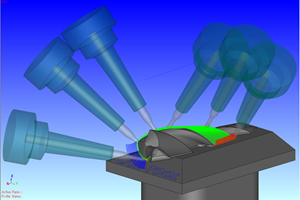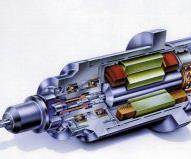Why You Should Use High-Speed Machining with Micro-Tooling
Faster machining, lower force, less tool breakage, no thermal growth, better surface finish and better part quality can be achieved by using high-speed machining with micro-tooling.
There are many benefits to using high-speed machining (HSM) with micro-tooling operations when dealing with nonferrous metals or plastics, but challenges of micro-tooling, available technology and feeds and speeds also need to be taken into consideration.
Micro-tooling involves mills and drills with a diameter of 0.250" or less. It is required for intricate, very detailed machining and works best with high-speed spindles. HSM has no set definition or absolute parameters, but one workable definition is machining with spindle speeds of 25,000 rpm or more.
Challenges
Workpiece sizes are decreasing, while part versions increase. The miniaturization in the manufacturing world demands changes in the manufacturing process. These increased demands require rethinking in order to work more efficiently with smaller tool diameters, which require higher rpm speeds that most conventional spindles cannot achieve. Even if they can, it puts undue stress on them by constantly red-lining the spindles. Conventional CNC equipment using tools smaller than 1/2" diameter at 10,000 rpm or less usually results in unfavorable feedrates and costly tool breakage.
The traditional method of machining involves using comparatively large tools at fairly low speeds. Inherent to its design, a larger tool is often unsuitable for intricate machining. In order to attempt machining with micro-tooling, conventional machines must run very slowly and have a tendency to easily break the fragile tools.
Large tools, by virtue of their mass, are resilient to the effect of chips. Smaller tools, on the other hand, are fragile and more susceptible to breakage. Improper chip evacuation is a major cause of tool breakage. In fact, more small tools break because of inadequate chip removal than they do for incorrect machining parameters.
Chips must be removed from the cutting channel in order to minimize breakage possibilities. Small tools require high spindle speeds, but they need to go even faster in order to kick the chips out.
The best approach to efficiently machine with small tooling is a three-fold process. The three interrelated elements are:
1. Micro-tooling design
2. Low-viscosity coolant
3. HSM technology
Micro-Tooling Design
Scaling down the tool geometry of larger diameter tools to a smaller format yields unacceptable feedrates and unsatisfactory finishes. Tooling requirements change when tool diameter is decreased and spindle speed is increased. Conventional tooling using inserts is not appropriate for micro-tooling applications. This is primarily due to the required higher rpm rate rather than the tool diameters involved. Increased rpm rates require a properly balanced tool with significantly increased chip room to assure proper chip removal and prevent chip burn-up. Efficient machining with small tools requires the tools to be optimized specifically for HSM applications. The proper geometry of micro-tooling, together with high-speed spindles and proper coolant, can totally eliminate deburring as a secondary operation.
Low-Viscosity Coolant
HSM with micro-tooling creates enough heat that steps can be required in order to cool things down. While HSM technology has certain advantages that work toward reducing heat, that technology alone is sometimes insufficient to handle the entire task of cooling. An efficient coolant system is still required for certain applications.
The coolant eliminates heat and serves as a lubricant, thus enabling the tool to move swiftly across the surface. Trying to cut a cold block of butter with a cold knife is difficult work because there's nothing aiding the blade as it tries to move across the butter's surface. However, if the knife is heated, it will effectively melt some of the butter, providing lubrication to the blade and enabling it to move easily across the butter, so efficient cutting can be accomplished. The same principle works with HSM. The micro-tooling needs a lubricating agent with a lower viscosity than water because the coolant needs to make it to the cutting edge of the tool at the high spindle speeds. Emulsion-based coolants have a higher viscosity than water, and thus are ineffective as a lubricant for HSM with micro-tooling.
Micro-volume coolant spray systems can use ethanol-a form of alcohol, which occurs naturally in the sugar fermentation process. Ethanol is ideal for nonferrous metals and some plastics; however, steel-based materials require an oil-based coolant. Thus, the advantages of ethanol coolant are not available for ferrous machining because carbide tooling on steel surfaces can cause sparks, which could create a rather highly dynamic situation if exposed to an alcohol-based coolant.
Conventional flood coolant is petroleum-based, which needs to be properly disposed of with attendant costs. Ethanol doesn't need to be disposed of or recycled because it simply evaporates. Although flammable, the low evaporation point makes ethanol a very efficient cooling and lubricating agent for HSM operations. Since it's a natural chemical, there's no negative environmental impact, no waste, no clean up and, therefore, no cost. In addition, ethanol as a coolant does not leave any residue on the machined parts, eliminating the costly secondary operation of degreasing the parts.
HSM Technology
The smaller the tooling, the higher the spindle speed you will need to efficiently machine the parts. High-frequency spindles with speed ranges from 6,000 to 60,000 rpm are ideal for milling, drilling, thread milling and engraving using micro-tooling.
HSM technology uses high rpm rates, taking a smaller step-over, but with significantly increased feedrates. Move your hand through the flame of a burning candle. If you move too slowly, there's enough time for the flame to cause damage. On the other hand, if you sweep your hand swiftly through the flame, there's insufficient time for the fire to damage your skin. The same principle applies to HSM with micro-tooling. If the spindles move fast, there's insufficient time for heat to feed back into the part and cause issues.
During the machining process, the tool continually carves a chip out of the workpiece. The generated heat develops from approximately 40 percent friction on each side of the tool and 20 percent from the deformation (bending) of the chip. Therefore, about 60 percent of the heat is inside of the chip. HSM tries to evacuate the bulk of the heat with the chip, providing for a cleaner cut. The better machining quality is based on cooler tooling, lower machining forces and less vibration.
The high spindle speed reduces the chip load to less than 0.005". Such a low chip load significantly reduces the forces between the tool and the material. High-speed/low-force machining develops less heat, reduces tool deflection and allows machining of thinner walled workpieces. This results in better surface quality, cooler machining, easier workholding and better accuracy.
Machine Dynamics
The interrelated elements of these three available technologies are possible because of the dynamic nature of machines that perform HSM with micro-tooling. The latter are relatively lightweight, which gives them a wide range of motion, agility, flexibility and versatility, coupled with impressive speeds. Conventional machines are heavier and don't have the same degree of speed and maneuverability, but can machine with larger tooling. Conventional machines are like SUVs; though powerful, they lack high maneuverability or the ability to stop on a dime. Sports cars, on the other hand, also are powerful, but possess a high degree of control and nimbleness due to their very design and construction. This describes exactly what machines capable of HSM with micro-tooling are all about.
In addition, just as you can't put a spoiler and racing stripes on an SUV and expect it to perform like a sports car, you can't retrofit a high-speed spindle onto a clunky conventional machine and expect it to efficiently accomplish HSM with micro-tooling.
When designing a machine, you can go in one of two directions:
1. You can build your machine big and powerful, enabling it to drive big tools with a big spindle. Driving big tools requires high force, which means a big motor with heavy mass.
2. You can build a lighter machine specifically for micro-tooling. A machine designed for HSM with micro-tooling inherently encounters less machining force, and can be designed for speed and nimbleness without requiring a big motor to drive it.
The Solution
The best solution for achieving efficient HSM is using the three-fold process: micro-tooling design, low-viscosity coolant and HSM technology. Each part of the process is equally important in order to achieve efficient HSM. When they are applied together, they can provide breathtaking manufacturing speeds and improved product quality. HSM with micro-tooling offers lower force, less tool breakage, no thermal growth, better surface finish, elimination of deburring and degreasing and less tool vibration. Spindle speeds of up to 60,000 rpm allow faster machining with micro-tooling, while providing better part quality.
Related Content
Mold Innovations Power Unique Auto Lighting Elements on Hummer EVs
Diamond machining, electroforming of micro-optical inserts and modified latch-lock system help injection molds produce unique forward lighting elements.
Read MoreHow to Generate the Ideal Tool Path for High-Level Accuracy and Finish
When a mold builder can’t compromise part accuracy and surface finish, CAM software with specialized programming strategies is essential.
Read MoreDevelopments in High-Speed Machining Technology
There have been many exciting developments in high-speed machining relative to machining centers and controls, tooling and CAD/CAM systems.
Read MoreRead Next
Micro Tooling for a Growing Micro Moldmaking Market
Without proper tooling, one cannot imagine the challenges of entering a world of micro machining where the tooling used is sometimes also very challenging to see.
Read MoreAre You a Moldmaker Considering 3D Printing? Consider the 3D Printing Workshop at NPE2024
Presentations will cover 3D printing for mold tooling, material innovation, product development, bridge production and full-scale, high-volume additive manufacturing.
Read MoreHow to Use Continuing Education to Remain Competitive in Moldmaking
Continued training helps moldmakers make tooling decisions and properly use the latest cutting tool to efficiently machine high-quality molds.
Read More





















